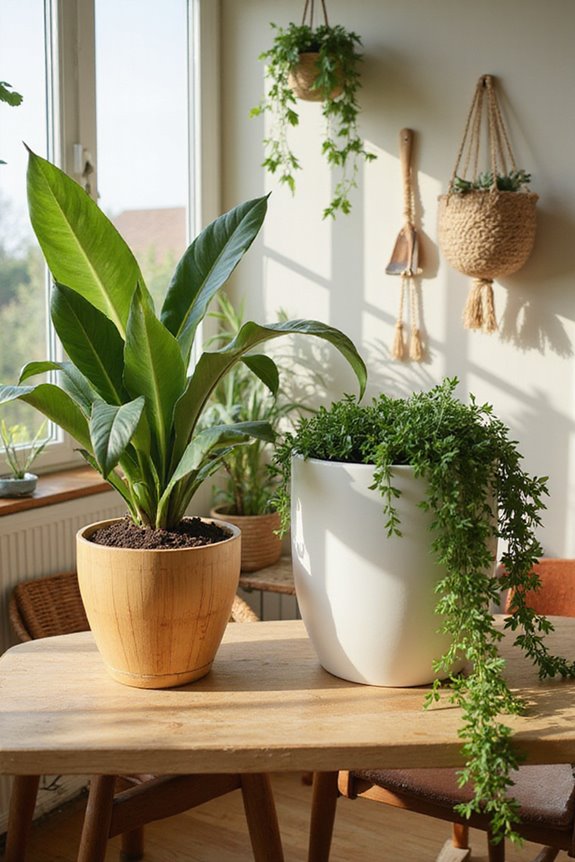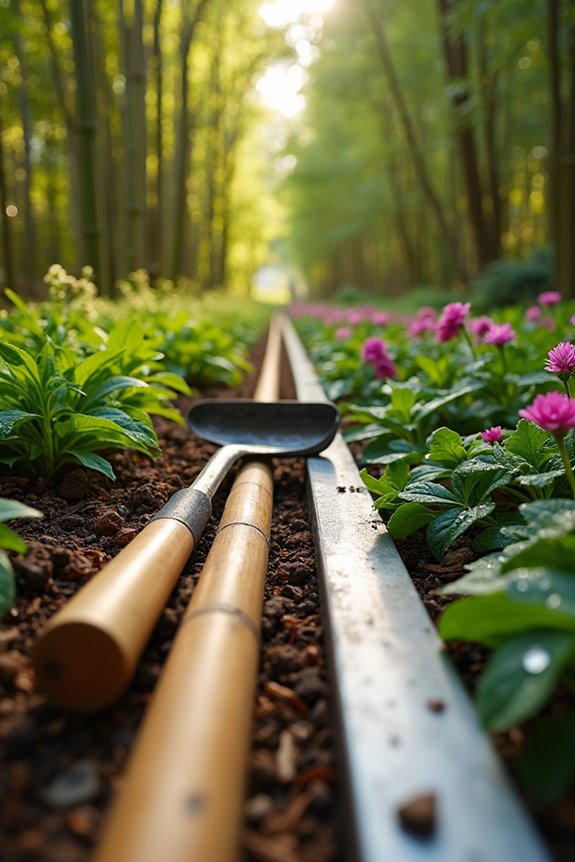When choosing between bamboo and ceramic planters, we should consider several factors. Bamboo planters are lightweight, durable, and biodegradable, making them an eco-friendly choice. They also offer a natural, rustic appearance. On the other hand, ceramic planters bring elegance and sophistication with their variety of designs but can be heavy and breakable. Both require care for healthy plants, such as proper drainage. If we explore further, we can uncover more about the strengths of each option.
Key Takeaways
- Bamboo planters are lightweight and portable, making them easy to rearrange, while ceramic planters are heavier and more cumbersome when filled.
- Bamboo is biodegradable and made from renewable resources, whereas ceramic planters are not biodegradable and have a higher carbon footprint due to energy-intensive production.
- Ceramic planters offer a variety of elegant glazed finishes, while bamboo showcases a natural wood-grain aesthetic that enhances rustic themes.
- Both planter types require proper drainage, but bamboo needs careful attention to prevent root rot, while ceramic requires regular cleaning to avoid water stains.
- Bamboo planters can withstand outdoor conditions due to their water resistance, while ceramic planters may be prone to cracking under extreme weather.
Material Composition and Durability
When we compare bamboo and ceramic planters, their material composition and durability stand out as key factors. Bamboo planters are made from natural bamboo fibers, which provide impressive tensile strength. They’re treated to resist water, insects, and fungus, making them durable for outdoor use. On the other hand, ceramic planters consist of ceramic minerals like kaolinite and quartz. They’re strong and weather-resistant but can be brittle and prone to cracking.
- Bamboo Planters:
- High tensile strength, comparable to steel.
- Antibacterial and antifungal properties enhance durability. Bamboo stakes are biodegradable and made from renewable materials, further supporting their eco-friendliness.
- Non-porous and stable but can chip or crack.
- Resistant to biological degradation.
Both materials offer unique strengths, appealing to different gardening needs.
Appearance and Aesthetic Appeal
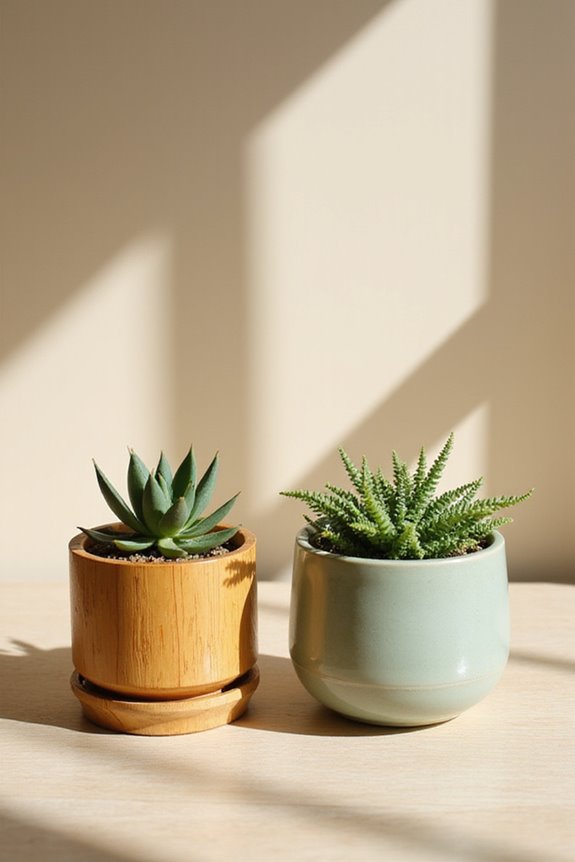
While both bamboo and ceramic planters have their unique visual charm, they cater to different aesthetic preferences.
- Design Influences
- Ceramic planters often feature handpainted bamboo motifs, adding elegance.
- Bamboo planters showcase a natural wood-grain aesthetic, enriching rustic themes.
- Ceramic offers a variety of glazed finishes, enhancing sophistication.
- Bamboo retains its organic hues, developing a weathered charm over time.
- Bamboo complements rustic and eco-friendly spaces.
- Ceramic fits seamlessly in modern and upscale designs.
In blending these elements, we can create visual harmony in our spaces, whether we prefer the organic warmth of bamboo or the refined artistry of ceramic. Additionally, the use of eco-friendly materials like bamboo can significantly reduce environmental impact, making it a popular choice for sustainable living.
Weight and Portability
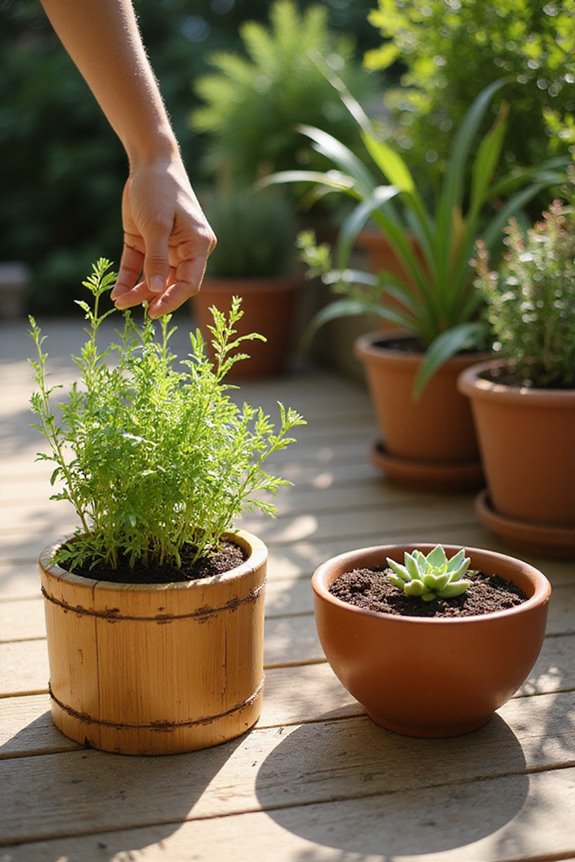
Weight plays an essential role in the practicality of bamboo and ceramic planters.
1. Weight Distribution
Bamboo planters are lightweight, making them easy to move. This portability allows us to rearrange plants without hassle. In contrast, ceramic planters are heavier and can become cumbersome once filled with soil and plants.
2. Transportation Ease
When it comes to transporting planters, bamboo wins. Its natural flexibility makes it less prone to damage, while ceramic planters require careful handling to avoid breakage. Additionally, the added weight of ceramic reduces mobility, often necessitating assistance for movement.
3. Practical Usage
For seasonal gardening or frequent changes, bamboo planters are ideal. Their lightweight nature supports our need for flexibility in plant placement, enhancing our gardening experience. Moreover, bamboo is a sustainable resource that contributes to eco-friendly gardening practices.
Environmental Impact
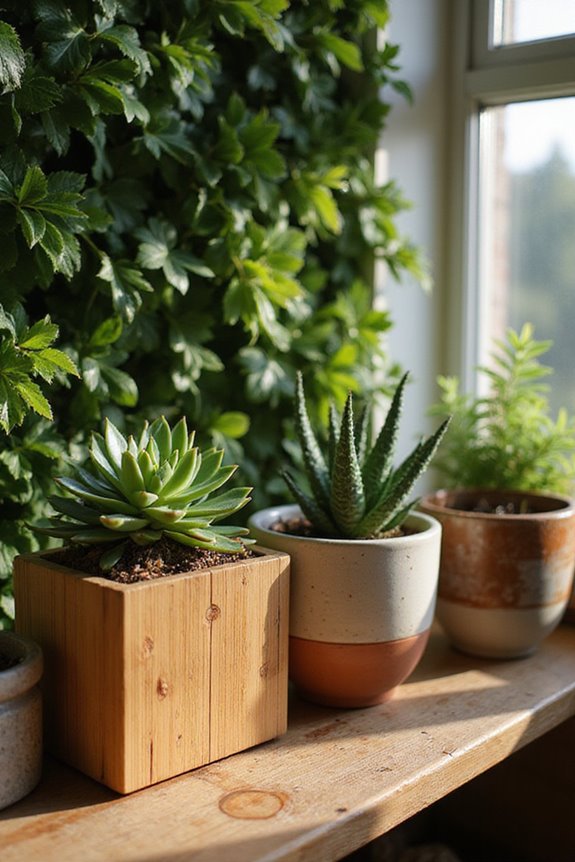
Environmental impact is a crucial factor to evaluate when choosing between bamboo and ceramic planters. Let’s consider some key points regarding sustainability metrics and ecological footprint.
- Resource Renewability: Bamboo grows rapidly and can be harvested every 3–5 years, while ceramics require energy-intensive extraction and processing.
- Carbon Footprint: Bamboo absorbs CO₂ considerably during its growth, helping to lower its carbon footprint. Conversely, ceramic production is energy-heavy and does not sequester carbon.
- Biodegradability: Bamboo planters are biodegradable and compostable, reducing landfill waste. In contrast, ceramic planters are not readily biodegradable and often end up in landfills.
Additionally, bamboo’s rapid growth provides immediate environmental benefits, further enhancing its appeal as a sustainable option.
Ultimately, bamboo offers clear environmental advantages over ceramics, making it a stronger choice for those focused on sustainability.
Maintenance and Care
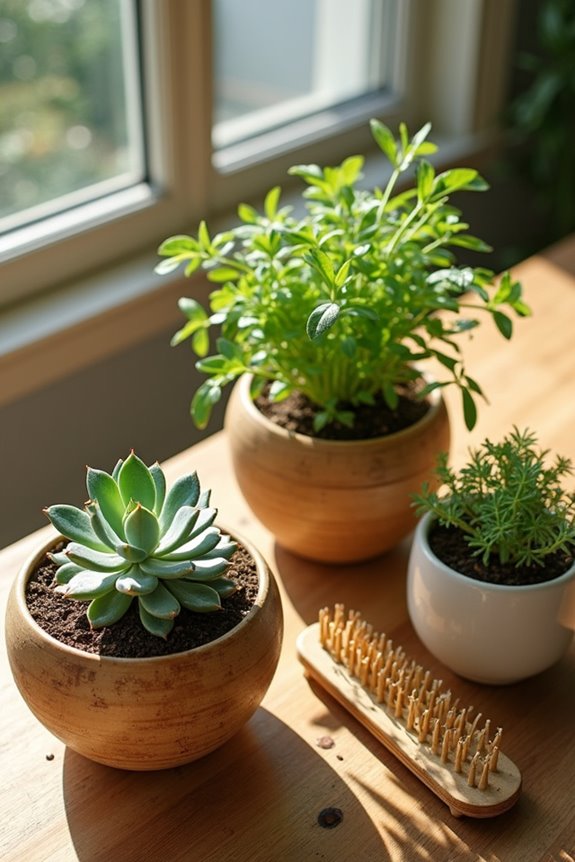
When it comes to maintaining bamboo and ceramic planters, understanding their specific needs is vital for healthy plant growth. For bamboo, we must guarantee proper drainage to prevent root rot. This means avoiding standing water and soggy soil. We should use raised bases or air gaps underneath to enhance drainage.
Ceramic planters, while durable, require regular cleaning to manage water stains and mineral deposits. Their porous nature means we need to monitor soil moisture closely and adjust our watering techniques accordingly. Additionally, using eco-friendly bamboo stakes can provide much-needed support for plants, ensuring they thrive in both planter types.
In both planter types, effective soil management is significant. We need to check for soil sogginess and adjust our watering frequency to avoid issues. By staying attentive, we can create thriving environments for our plants.
Cost and Value
Cost and value are essential considerations when choosing between bamboo and ceramic planters. The initial investment for bamboo planters can be lower, with standalone pieces often priced under $20. However, they may require more frequent replacement due to their susceptibility to moisture. In contrast, ceramic planters range from $10 to over $70, but their durability means they can last for decades. When it comes to resale potential, ceramic planters tend to maintain their value, especially if they’re stylish or handcrafted. Bamboo items, on the other hand, often lose value quickly if they degrade. Overall, while bamboo may seem cost-effective upfront, ceramic planters offer better long-term value, making them a wise investment for our plant-loving community. Additionally, choosing high-quality bamboo flooring can extend the lifespan of bamboo products by ensuring superior durability against wear and moisture.
Choosing the Right Planter for Your Needs
Choosing the right planter for your needs involves considering various factors that align with your gardening goals. Here are some planter selection tips to help us decide:
- Durability: If we want longevity, ceramic planters are a great choice. They can last decades, while bamboo planters need more upkeep to avoid decay.
- Aesthetics: Bamboo offers a rustic charm, while ceramic comes in vibrant colors and various styles. Consider what fits our space best.
- Weight: For frequent rearranging, bamboo is lighter and easier to move. Ceramic, although heavier, provides stability for larger plants.
- Maintenance: Ceramic is low-maintenance, while bamboo requires sealing to prevent rot.
Frequently Asked Questions
Can Bamboo Planters Be Used Indoors Without Concerns?
Imagine lush greenery thriving in our cozy indoor space; bamboo planters offer safety and beauty. With their moisture resistance and eco-friendliness, we can embrace indoor gardening tips confidently, enjoying all the bamboo planter benefits together!
Are Ceramic Planters Available in Non-Glazed Options?
Yes, we can find unglazed ceramic options! These ceramic planters offer great benefits, like improved air circulation and moisture release, making them perfect for our plants that need a little extra love and care.
How Do Bamboo Planters Affect Soil Moisture Levels?
Ah, dear reader, in our exploration of soil moisture, we find bamboo planters may struggle with water retention, allowing moisture to escape more readily. Together, we can enhance their performance with thoughtful soil choices and care.
Can Bamboo Planters Withstand Extreme Weather Conditions?
We believe bamboo planters can withstand extreme weather conditions to some extent, but their durability and weather resistance vary. Proper care and placement help enhance their performance in challenging environments, ensuring our plants thrive together.
Are There Specific Plants Best Suited for Each Planter Type?
Isn’t it fascinating how plant compatibility varies with planter aesthetics? We’ve found that vibrant blooms thrive in ceramic pots, while towering bamboo flourishes in sturdy containers, showcasing nature’s beauty in our shared gardening journey.

